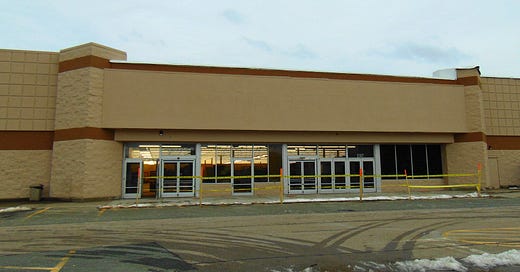One of my long-time interests is old retail—the buildings, the concepts, the logos, etc. Finding out about old stores and chains from the internet is kind of like using the fossil record to learn about extinct species; there’s a record of them, but it’s spotty, and not totally representative of what actually existed. It has always fascinated me, even on some level when I was a kid, that something as ordinary and recent as defunct chain retail can still just kind of be lost to time. (Some of the best resources here are the blogs Labelscar and Pleasant Family Shopping.)
I’m thinking about all this because recently I came across a little internet post on an old discount chain called Bud’s Discount City. In its early days, Walmart was named Wal-Mart Discount City. It turns out the chains were related: James “Bud” Walton was Walmart founder Sam Walton’s younger brother, and Bud’s Discount City was, in a way, the younger brother to Walmart. Despite probably knowing more old retail trivia than most people, I had never heard of Bud’s before, which existed only from 1990 to 1997 or ’98. Here’s a picture of a typical location, and here’s a good summary of the chain.
Often located in older, smaller former Walmarts, Bud’s were essentially in-house liquidation stores, selling overstock, out-of-season, “scratch and dent,” and, crucially, returned merchandise. Apparently, Walmart’s size and easy return policy led to a lot of returns that were basically perfectly good, but opened. Given the volume, these returns would produce logistical issues and clutter shelves.
Today, most large retailers have answered the returns problem by outsourcing return processing entirely; returned merchandise is bundled into pallets and sold to liquidators (I touched on some of that here). Walmart answered it, for a few years, by outsourcing returns to an entire closeout-themed division of its own company! I believe that is pretty much unique in retail, and there’s probably a good reason it didn’t last.
But wait, there’s more. As noted, these were located in old Walmart buildings. This, even more than the returns issue, may have been the real purpose of the short-lived chain. As Walmart went on a Supercenter-building spree in the 1990s, they left quite a lot of older, smaller locations vacant, often just a couple of miles away—and often accompanied by the shells of the other, smaller discount stores they drove out of business. (There were easily 20 or 30 national or large regional discount department store chains in America as recently as the mid-1990s.)
In addition to rising concern over Walmart’s effects on small-town economies in this era, the move to Supercenters left Walmart with leases on the old locations, and they generally refused to allow other competing chains to lease their own former locations from them. So the Bud’s stores were a way to sort of patch up an empty building and also to fulfill and monetize their leases with commercial landlords.
If Walmart is known for anything other than low prices, it’s for being a predictable experience, like McDonald’s. So the Bud’s stores, relying on whatever the main stores happened to be liquidating or receiving as returns, seem to run against the Walmart ethos. They’re more like Ollie’s or Big Lots, occupying an interesting space between a mainstream discount department store and a thrift store. They were also a kind of kludgey solution to a few disparate problems, which is kind of an odd basis for a large retail chain. In 1997, the majority of the stores, underperforming and not worth the trouble, were closed. The rest were closed soon thereafter, and the chain is basically forgotten today.
I like these kinds of stories because on the one hand, they’re a bit quaint and blast-from-the-past. It feels like ages ago when Walmart was the primary archetype of corporate malfeasance, and when scores of small towns, now either dead or renewing themselves, were still hanging by a thread to their old, local economies, often anchored by downtown retail and some kind of industry. And it feels even longer ago that offshoring and free trade—a big part of Walmart’s bottom-dollar pricing—were still ongoing processes rather than faits accompli.
On the other hand, however, Bud’s can serve as a reminder that while big-box retail isn’t all bad, and isn’t a cartoon villain, the problems with it are real, and they’ve been with us for a long time. Today, they take a different shape; rather than getting creative with retail concepts, retailers have gotten creative with the law. They’ve invented “dark store theory,” a wonky legal theory arguing, as far as I can tell, that the glut of worthless, vacant big-box stores suggests that even thriving stores should be valued—and therefore, taxed—at a much lower rate. This is cynical, self-serving, and in some sense, maybe true.
Why are these stores worthless? Partly because they’re single-use structures that are very difficult to adapt, except as other large stores. And the number of stores that need a big-box physical footprint is dwindling. All of that, however, is a different issue. Until next time!
Photo credit: JJBers/Flickr, CC BY 2.0. A typical older Walmart building. Most Bud’s would have been this model, or an even earlier one.




Our not-that-large town of 18,000ish had a Wal-Mart followed by a Super Wal-Mart, also separated by not many years or miles. I'm not sure how all the details transpired, but one of the larger churches in town ended up using the old structure.